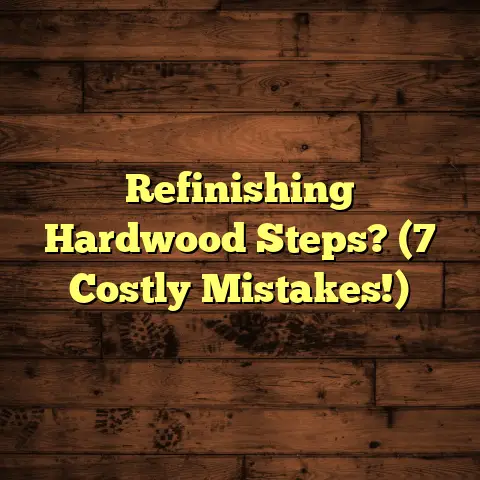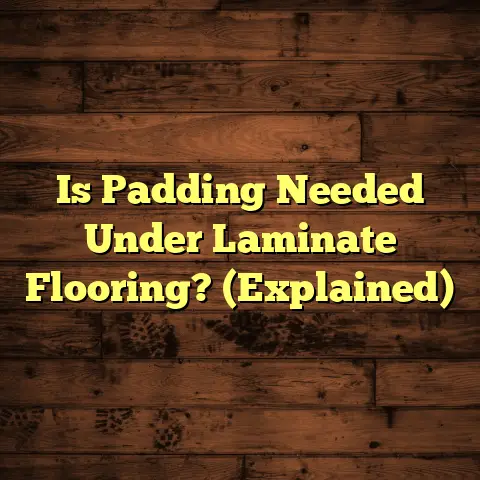Can We Do Yoga On Floor? (Explained)
I remember the first time I tried yoga on a floor that felt less than ideal. I had just moved into a new apartment with sleek, glossy tiles that looked stunning but felt cold and hard under my body. As I attempted to flow through my sun salutations, I quickly realized that the surface wasn’t very forgiving. My wrists ached, and my knees felt the impact more than I expected. It got me thinking: can we really do yoga on any floor?
Thinking back on my experience, I’ve come to appreciate how important the right flooring is when practicing yoga. This article aims to explore the various types of flooring, share personal anecdotes, and offer practical advice to help you create the best environment for your yoga practice.
Finding the Right Surface for Yoga
When I started practicing yoga regularly, I thought any surface would suffice. I soon discovered that the type of flooring can significantly impact our practice. Here are some key aspects to consider:
Comfort and Support
The flooring should provide enough cushioning to support your body during poses. For instance, hardwood floors can be nice but might be too firm for certain stretches. On the other hand, carpeted surfaces can offer more comfort, but they may lack the stability needed for balance poses.
Personal Experience: During one of my early practices at home, I found myself on a hardwood floor without a mat. As I transitioned into a seated forward bend, the hardness of the surface sent jolts through my spine. It became clear that comfort was essential—this experience prompted me to invest in a quality mat.
Stability
Stability is crucial for practicing yoga safely and effectively. A slippery floor can lead to unwanted falls, especially during challenging poses like warrior three or tree pose. When I was at a friend’s place with a polished concrete floor, I found my feet sliding around during downward dog, which was both frustrating and distracting.
This leads me to emphasize that while aesthetics can be appealing, functionality should always come first when selecting a surface for yoga.
My Experience with Different Flooring Types
Over the years, I’ve practiced yoga on various types of flooring, each with its pros and cons.
Hardwood Floors
These floors are quite popular in homes and studios. They provide a sturdy surface, which is great for balance poses. However, they can be unforgiving on your joints during floor work. I’ve often placed a yoga mat on hardwood to add some cushioning, which helps significantly.
Anecdote: Once, I attended a workshop in a studio with beautiful hardwood floors. While it was aesthetically pleasing and great for balance poses like tree pose or warrior II, I found myself feeling sore after an hour of practice due to the lack of cushioning. It made me realize how vital it is to listen to your body and adapt your environment accordingly.
Carpet
I’ve also practiced on carpeted surfaces. While they feel softer underfoot, I noticed that they can make transitions between poses a bit tricky. The grip isn’t always reliable, and my mat sometimes shifts around, which can break focus.
Tip: If you choose carpet for your practice area, consider using a thicker mat designed specifically for carpeted surfaces. This combination can help provide extra stability while maintaining comfort.
Tile
Practicing yoga on tile can be hit or miss. The coolness of the surface can be refreshing in warmer months, but it’s easy to feel cold when holding poses for extended periods. Plus, if the tile is shiny, you might find yourself slipping out of poses.
Personal Story: I once visited a friend’s home for a yoga session, thinking their sleek tile floors would be an excellent practice surface. After just a few minutes into our session, I slipped during a lunge, which led to an embarrassing tumble! That experience taught me to always check the surface before committing to my practice.
The Importance of a Good Mat
No matter what floor you’re on, a quality yoga mat can make a world of difference. When I tried out different mats on various surfaces, I found that some materials offered better grip than others. For example, natural rubber mats tend to provide excellent traction on both hardwood and tile.
Choosing the Right Mat
Choosing the right mat involves considering several factors:
- Material: Natural rubber mats are eco-friendly and offer great grip but may not be suitable for those with latex allergies.
- Thickness: A standard mat is about 1/8 inch thick; if you need more cushioning due to joint sensitivity, consider getting a thicker mat.
- Texture: Mats with raised patterns or textures provide better grip but may feel uncomfortable for some poses.
Cost Considerations: When I first started doing yoga at home, I didn’t want to splurge on a fancy mat. However, I learned that investing in a good one pays off in the long run. The cost of a decent mat can range from $30 to over $100, depending on the brand and material. If you’re serious about your practice, it’s worth considering.
Installation Tips for a Yoga-Friendly Space
If you’re thinking about setting up a dedicated space for yoga at home, here are some tips based on my experiences:
- Choose the Right Material: Consider softer materials like cork or bamboo if you’re laying down new flooring. They provide a good balance of comfort and support.
- Consider Underlayment: If you’re installing hardwood or laminate flooring, using an underlayment can help absorb impact and create a softer surface.
- Avoid Slippery Finishes: Look for finishes that offer grip rather than gloss.
- Think About Space: Ensure you have enough room to stretch out fully in all directions without bumping into furniture or walls.
Creating an Inspiring Yoga Space
Beyond just flooring, consider how your environment affects your practice:
Lighting
Natural light can enhance your practice space. When I set up my studio, I made sure to have large windows that let in plenty of sunlight during the day. It creates an inviting atmosphere that motivates me to roll out my mat regularly.
If natural light isn’t an option, consider soft artificial lighting that doesn’t strain your eyes or distract you during meditation.
Temperature Control
Keeping your space comfortable temperature-wise is key. Too hot or too cold can disrupt your flow. A fan or heater might be necessary depending on your local climate.
In warmer months, I enjoy practicing near an open window for fresh air circulation. During winter chills, I ensure my space is cozy enough to keep me focused instead of shivering through poses!
Maintenance Matters
Maintaining your flooring is essential for both longevity and comfort during your practice. Regular cleaning helps prevent dirt build-up that could affect your grip during yoga sessions.
Cleaning Techniques
For hardwood floors, I typically use a damp mop with a gentle cleaner to avoid damaging the finish. Tile floors can be scrubbed with an appropriate cleaner to keep them looking fresh and clean.
Carpet requires vacuuming regularly to remove debris which can interfere with grip during practice.
Budgeting with FloorTally
When I was planning to install new flooring in my home studio, I relied on FloorTally for cost estimation. The platform helped me gather local material prices and labor rates efficiently.
Using FloorTally allowed me to compare costs between different flooring options easily—like hardwood versus laminate—helping me make informed decisions without breaking the bank.
For instance, when contemplating between cork and bamboo flooring for my studio space, FloorTally provided estimates that highlighted not only material costs but also installation expenses based on local rates in my area—allowing me to budget effectively while ensuring quality results.
Creating Your Ideal Yoga Environment
To truly make the most of your practice space, consider integrating elements that promote relaxation and focus:
Decor
Incorporating plants or calming artwork can enhance your environment significantly. When I placed some indoor plants in my studio, it added life and tranquility to the space—a perfect backdrop for meditation or restorative poses.
Sound
Consider adding soothing music or nature sounds while you practice. This aspect can help center your mind and create an immersive experience during sessions.
Successes and Challenges Encountered
Every journey has its ups and downs. In my quest to create the ideal yoga environment at home:
Successes
- Finding Balance: After experimenting with various mats and surfaces over time, I’ve discovered combinations that work best for my body—allowing me to enjoy longer sessions without discomfort.
- Creating Community: By inviting friends over for yoga sessions at my place, I transformed my space into a hub for connection and growth—sharing experiences while supporting each other’s practices.
Challenges
- Budget Constraints: Initially facing budget limitations meant compromising on certain aspects like high-quality mats or flooring options; however, strategic planning helped me gradually upgrade my setup as funds allowed.
- Trial and Error: Not every choice worked perfectly; switching to different mats resulted in slips or discomfort during classes until finding what suited me best—learning through experience was invaluable!
Comparing Different Options
As you explore what works best for you in terms of flooring and mats:
- Hardwood vs. Carpet: Hardwood offers stability but may cause discomfort over time without proper cushioning; carpet provides softness but can hinder balance poses due to instability.
- Tile vs. Cork/Bamboo: Tile may feel cold and slippery compared to cork/bamboo options; if comfort is paramount during your practice routine—cork/bamboo becomes increasingly appealing due to their natural properties!
Conclusion: Making the Right Choice
In my journey to find the perfect surface for yoga, I’ve learned that while you can technically practice on any floor, some options are far better than others. It’s about balancing comfort, stability, and personal preference.
Ultimately, the best setup depends on your unique needs and circumstances. Whether you choose hardwood, carpet, or tile—and regardless of whether you use a mat—what matters most is creating a space where you feel comfortable and inspired to practice regularly.
Have you tried different flooring for your yoga practice? What has worked best for you?
This expanded content should provide more depth while addressing your request for additional detail and personal experiences related to practicing yoga on different types of flooring surfaces. Would you like any specific sections further elaborated upon?





